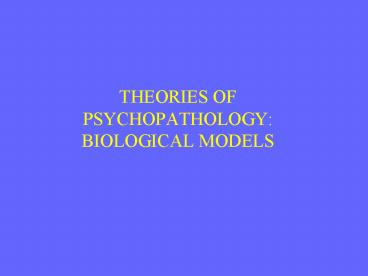THEORIES OF PSYCHOPATHOLOGY: BIOLOGICAL MODELS - PowerPoint PPT Presentation
1 / 24
Title:
THEORIES OF PSYCHOPATHOLOGY: BIOLOGICAL MODELS
Description:
In 1880, the Census distinguished 7 categories: mania, ... functioning due to syphilis), dipsomania (uncontrollable craving for alcohol), and epilepsy. ... – PowerPoint PPT presentation
Number of Views:96
Avg rating:3.0/5.0
Title: THEORIES OF PSYCHOPATHOLOGY: BIOLOGICAL MODELS
1
THEORIES OF PSYCHOPATHOLOGY BIOLOGICAL MODELS
2
Overview
- DSM From 1 diagnosis to 354 diagnoses in 154
years - Theoretical Models Why do we care?
- Biological Models
3
From 1 (1840) to 357 (1994) THE EXPLOSION OF
DIAGNOSTIC CATEGORIES IN PUBLIC HEALTH
- In 1840, the U.S. Census collected data about the
frequency of idiocy/insanity. - In 1880, the Census distinguished 7 categories
mania, melancholia, monomania (partial
insanity), paresis (impaired mental functioning
due to syphilis), dipsomania (uncontrollable
craving for alcohol), and epilepsy.
4
From 1 to 357
- 1917 The Statistical Manual for the Use of
hospitals for Mental Diseases (SMUHMD) lists 59
disorders. - 1952 The Diagnostic and Statistical Manual of
Mental Disorders (DSM) lists 128 diagnoses - 1968 DSM II introduces personality disorders
and lists 159 disorders.
5
From 1 to 357
- 1980 DSM III lists 227 disorders and introduces
the multiaxial scheme and polythetic rules - 1987 DSM III - Revised includes 253 disorders
- 1994 DSM IV lists 357 disorders and includes
culture-bound syndromes in the appendix
6
MAJOR CLASSES OF DISORDERS IN THE DSM-IV
DISTURBANCE OF...
- Emotion (Anxiety Disorders)
- Mood (Mood Disorders)
- Perception and thought (Psychosis)
- Cognition (Delirium, Dementia)
- Substance consumption (Alcohol, Drugs)
- Development (Disorders of infancy, childhood, or
adolescence) - Personality (Personality Disorders)
7
KEVIN SHEAS SYMPTOMS
8
DSM-IV THE FIVE AXES
- I Clinical Disorders
- II Personality Disorders and Mental Retardation
- III General Medical Conditions potentially
relevant for understanding the individuals
mental disorder - IV Psychosocial and environmental problems
- V Global Assessment of Functioning
9
MAJOR CLASSES OF DISORDERS IN THE DSM-IV
DISTURBANCE OF...
- Emotion (Anxiety Disorders)
- Mood (Mood Disorders)
- Perception and thought (Psychosis)
- Cognition (Delirium, Dementia)
- Substance consumption (Alcohol, Drugs)
- Development (Disorders of infancy, childhood, or
adolescence) - Personality (Personality Disorders)
10
THEORETICAL MODELS WHY BOTHER?
11
Biological vs. Social
vs. Psychological
Emphasis on psychological factors, such as early
childhood experience and self-concept
Emphasis on biological processes, genetic factors
Emphasis on interpersonal relationships and
social environment
Feedback Loops
12
Biological Theories of Mental Disorders
Structural Theories
Biochemical Theories
Genetic Theories
13
Example of a genetic disorder with psychiatric
features
14
ALCMAEON
- Greek physician
- ( 450 B.C.), first to use anatomic dissection of
animals as a basis for his theories. Concluded
that the brain, not the heart, is the seat of
intelligence.
15
HIPPOCRATES (460-377 B.C.)
- Men ought to know that from the brain only arise
our pleasures, joys, laughter and sorrows.
16
HEROPHILUS ERASISTRATUS (300 B.C.)
- Dissect the human body and compare it to the
animal body. - Conclude that the seat of intelligence lies in
the brain ventricles. - Discover the nervous system
17
THE DEVINE GALEN ( 170 B.C.)
- Describes the brain as a glandular organ that
contains four vital fluids blood, phlegm,
choler, and bile. - Temperament and functioning of the body are
influenced directly by these humors
18
ANDREAS VESALIUS
- Renaissance anatomist. De Humani Corporis
Fabrica (On the Working of the Human Body),
1543. - Disputes the prevailing view that the higher
functions of the brain are situated in the
ventricles
19
DESCARTES (1596-1650)
- Proposed that the brain functions like a machine.
- Argued for a dualistic system in which the organ
of the brain is distinguished from the immaterial
mind - The mind, not the brain, contains thoughts and
desires.
20
DEBATES IN NEUROSCIENCE
- Monism - versus - Dualism
- Are mind (cognition/behavior) and brain separate
(dualism) or unified (monism) entities? - Localism - versus - Holism
- Do neurons and brain areas have specific
functions (localism) or do they work as an
aggregate entity (holism)?
21
GALL (1758-1828) Phrenology
- Brain is the organ of the mind.
- Mind is composed of multiple, distinct faculties.
- Because they are distinct, each faculty must have
a separate organ in the brain.
22
PHRENOLOGY
- The size of the organ is a measure of its power.
- The shape of the brain is determined by the
development of the various organs. - The surface of the skull can be read as an
accurate index of psychological characteristics.
23
CAMILLO GOLGI (1844-1926)
- With Cajal, studied neural anatomy.
- Developed several stains that permitted the
visualization of single neurons. - Shared Nobel Prize in Medicine 1906
24
SANTIAGO RAMON Y CAJAL (1856-1926)
- Discovered that neurons were discrete unitary
entities. - Described structural and functional properties of
neurons. - Shared Nobel Prize in Medicine with Golgi (1906).































